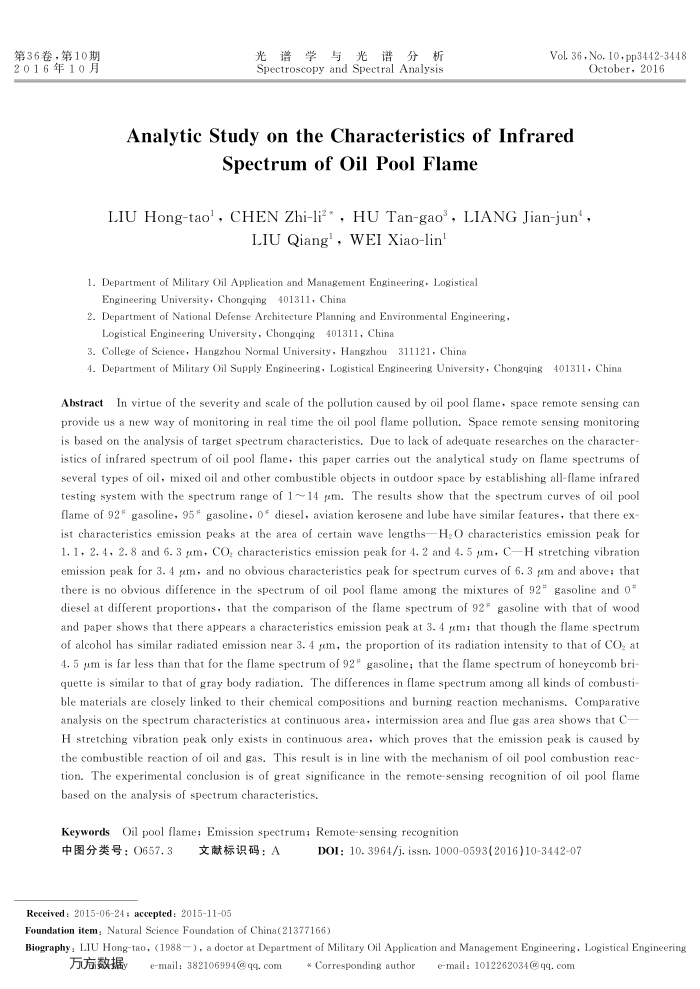您当前的位置:首页>论文资料>油料池火焰红外光谱特性分析研究
内容简介
 第36卷,第10期 2016年10月
第36卷,第10期 2016年10月光谱学与光谱分析 Spectroscopy and Spectral Analysis
Vol. 36,No.10+pp3442-3448
October,2016
Analytic Study ontheCharacteristicsofInfrared
Spectrumof OilPoolFlame
LIU Hong-tao',CHEN Zhi-li2*,HU Tan-gao",LIANG Jian-jun',
LIUQiang'WEIXiao-lin
1. Department of Military Oil Application and Management Engineering, Logistical Engineering University, Chongqing401311, China
2. Department of National Defense Architecture Planning and Environmental Engineering, Logistical Engineering University, Chongqing401311, China
3. College of Science, Hangzhou Normal University, Hangzhou 311121, China
4. Department of Military Oil Supply Engineering, Logistical Engineering University, Chongqing 401311, China
AbstractIn virtue of the severity and scale of the pollution caused by oil pool flame, space remote sensing can provide us a new way of monitoring in real time the oil pool flame pollution. Space remote sensing monitoring is based on the analysis of target spectrum characteristics. Due to lack of adequate researches on the character-istics of infrared spectrum of oil pool flame, this paper carries out the analytical study on flame spectrums of several types of oil, mixed oil and other combustible objects in outdoor space by establishing all-flame infrared testing system with the spectrum range of 1 ~ 14 μm. The results show that the spectrum curves of oil pool flame of 92# gasoline, 95# gasoline, 0* diesel, aviation kerosene and lube have similar features, that there ex ist characteristics emission peaks at the area of certain wave lengthsH, O characteristics emission peak for 1. 1, 2. 4, 2. 8 and 6. 3 μm, CO, characteristics emission peak for 4. 2 and 4. 5 μm, C—H stretching vibration emission peak for 3. 4 μm, and no obvious characteristics peak for spectrum curves of 6. 3 gm and above; that there is no obvious difference in the spectrum of oil pool flame among the mixtures of 92# gasoline and o diesel at different proportions, that the comparison of the flame spectrum of 92* gasoline with that of wood and paper shows that there appears a characteristics emission peak at 3. 4 gxm: that though the flame spectrum of alcohol has similar radiated emission near 3. 4 gm, the proportion of its radiation intensity to that of CO, at 4. 5 μm is far less than that for the flame spectrum of 92 * gasoline; that the flame spectrum of honeycomb bri-quette is similar to that of gray body radiation. The differences in flame spectrum among all kinds of combusti-ble materials are closely linked to their chemical compositions and burning reaction mechanisms. Comparative analysis on the spectrum characteristics at continuous area, intermission area and flue gas area shows that C H stretching vibration peak only exists in continuous area, which proves that the emission peak is caused by the combustible reaction of oil and gas. This result is in line with the mechanism of oil pool combustion reac tion. The experimental conclusion is of great significance in the remote-sensing recognition of oil pool flame based on the analysis of spectrum characteristics
Keywords Oil pool flame; Emission spectrum; Remotesensing recognition
中图分类号:0657.3
文献标识码:A
Received: 2015-06-24; aceepted: 2015-11-05
D0I: 10. 3964/j. issn. 10000593(2016)10-3442-07
Foundation item: Natural Science Foundation of China(21377166)
Biography : LIU Hong-tao, (1988) , a doctor at Department of Military Oil Application and Management Engineering, Logistical Engineering
万数据
e-mail: 382106994@qq.com
* Corresponding authon
e-mail: 1012262034@qq.com